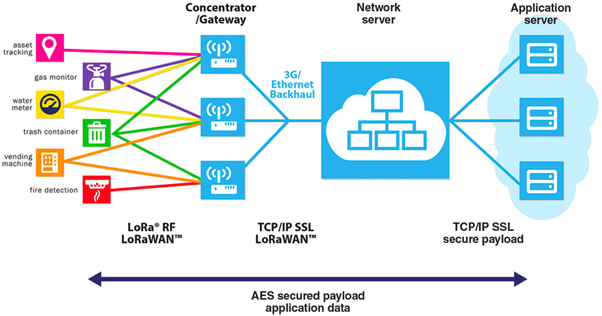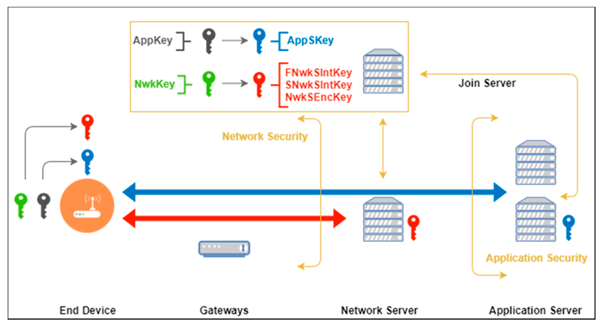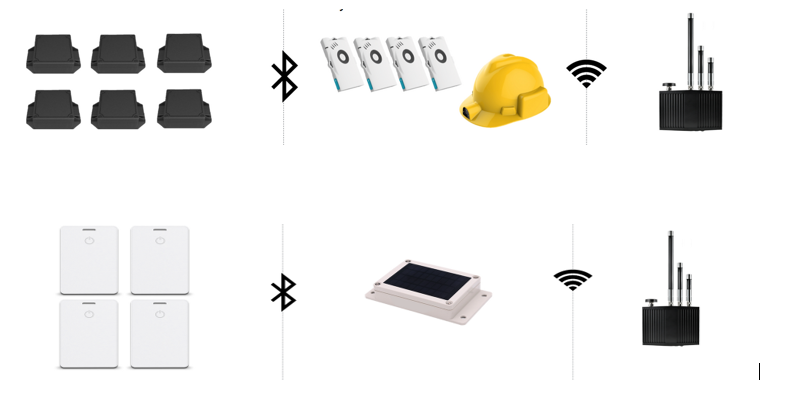LoRaWAN is a LoRa Alliance-developed Long Range Wide Area networking protocol that wirelessly connects 'things' to the internet in regional, national, or global networks, addressing key Internet of Things (IoT) requirements such as bi-directional communication, end-to-end security, mobility, and localization services.
LoRaWAN defines the network's communication protocol and system architecture using unlicensed spectrum in the ISM bands, while the LoRa physical layer establishes long-range communication links between remote sensors, beacons and gateways connected to the network. This protocol aids in the rapid establishment of public or private IoT networks utilising hardware and software from any location.
With LoRaWAN, an end device may connect to a network in two ways:
Over-the-Air Activation (OTAA): To connect to the network, a device must first establish a network key and an application session key.
Activation by Personalization (ABP): A device's keys for communicating with the network are hardcoded, resulting in a less secure but simpler connection.
LoRaWAN has two security layers: one for the network and one for the application. The application layer of security guarantees that the network operator does not have access to the end user's application data, while network security assures that each node in the network is legitimate. As a result, the LoRaWAN standard provides two cryptographic layers:
The end device and the network server exchange a 128-bit Network Session Key.
At the application level, a unique 128-bit Application Session Key (AppSKey) is shared end-to-end.
Data is encrypted by the node and then encrypted again by the LoRaWAN protocol before being transferred to the LoRa Gateway. The Gateway transmits data to the network server via a standard IP network. The Network server decrypts the LoRaWAN data using the Network Session Keys (NwkSkey). It then sends the data to the application server, which uses the Application Session Key to decrypt the data (AppSKey). The encryption will be added to the LoRaWAN communication protocol. LoRa transmissions are basic radio wave communications that cannot be encrypted on their own. There are two ways for LoRaWAN devices to connect to the network. The first is Over-the-Air-Activation or OTAA. A 128-bit AppKey is exchanged between the device and the network. The AppKey is used to construct a Message Integrity Code (MIC) when the device sends the join request, and the server then compares the MIC to the AppKey. If the check is successful, the server generates two new 128-bit keys: App Session Key (AppSkey) and Network Session Key (NetSkey) (NwkSkey). The AppKey is used as an encryption key to send these keys back to the device. The device decrypts and instals the two session keys after the keys are received. 
They have a large coverage area measured in kilometres, and they operate on free frequencies with no upfront licensing fees. Because of the low power consumption, gadgets have a long battery life, and device batteries can last for 2–5 years.LoRaWAN has the advantage of being a non-proprietary partnership with an open approach. The extended range allows smart city applications, but the low bandwidth makes it excellent for realistic IoT installations with limited data and/or variable data transfers. It offers cheaper connectivity costs, is wireless, and is simple to set up and deploy. With AES encryption, completely bi-directional communication, and the backing of CISCO, IBM, and 500 other LoRa Alliance member firms, it has a layer of security for the network and one for the application.
Limitations of LoRaWAN:
Large data payloads, payloads restricted to 100 bytes, continuous monitoring, and hard real-time applications needing reduced latency (typically in milliseconds) and defined jitter are not compatible with this technology. As the deployment of gateways populates metropolitan areas, the growth of LPWAN technologies, notably LoRaWAN, offers coexistence issues. Open frequency has the disadvantage of being susceptible to interference and having a poor data rate. You can broadcast on that frequency without interference if it is a GSM or licensed frequency. GSM providers who utilise certain frequencies must pay the government a substantial licence price to use those channels. LoRa uses free frequencies and does not require a state licence. However, keep in mind that open frequencies change from country to country.
How Advieta uses LoRaWAN:
Advieta leverages LoRaWAN technology to address areas where network connectivity or IT infrastructure can be challenging. The LoRa tags assigned to assets are BLE and/or RFID enabled. Some of them are also tested and proved to be water and dustproof with a battery life of 3 years. These tags sense anchors installed in the facility for referential location and transmit data to LoRa gateway which sends data to the Advieta’s cloud via a LoRa Network Server. The tags also come with SOS trigger buttons which can be used by a person during a life-threatening situation to alert the safety team to get help. The system is scalable which enables installing more anchors in the premises as the requirements progress via the user interface, thanks to no code configurability of the platform.
Apart from industry-specific implementations, LoRaWAN enables IoT in emerging nations where high-cost 5G alternatives are too expensive. The technology greatly decreases the cost of deployment due to its flexible, relatively simple design and minimal network hardware requirements, while its low energy consumption generates further savings in running expenditures. LoRaWAN, which was created to link devices to the internet wirelessly, is ideal for IoT sensors, trackers, and beacons with modest data traffic requirements and limited battery life. The protocol's inherent properties make it an excellent candidate for a wide range of applications.
